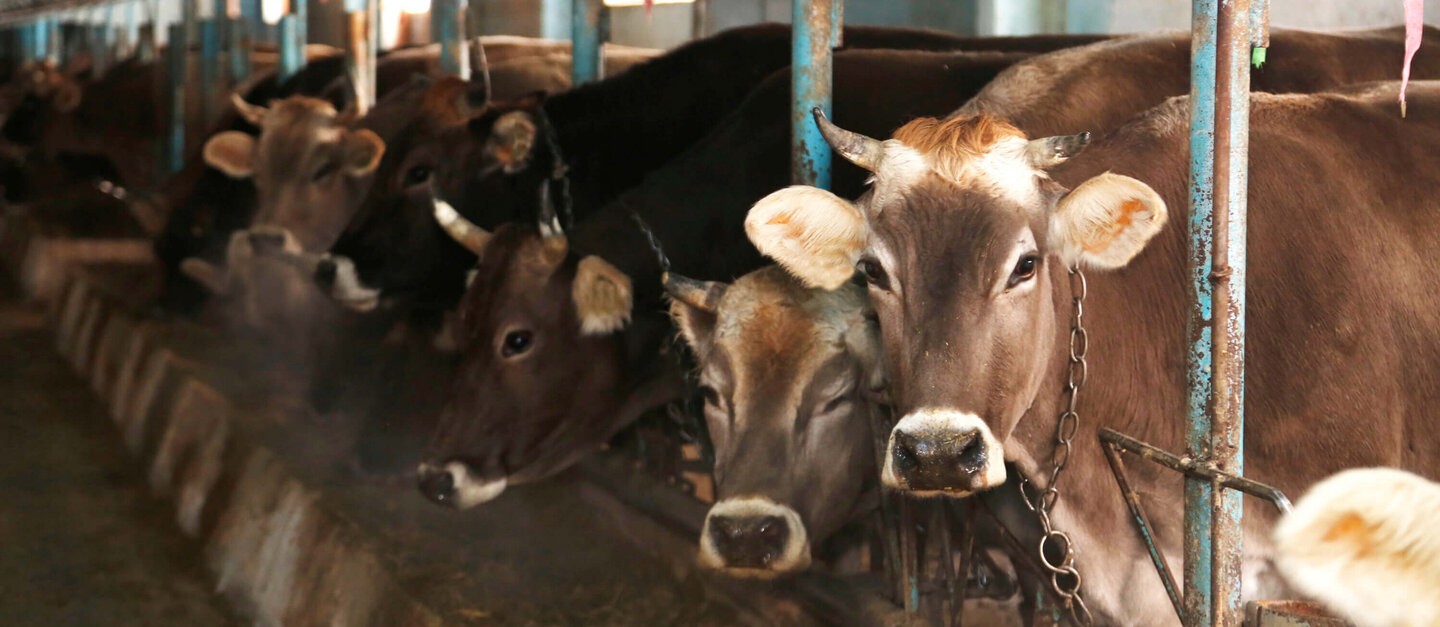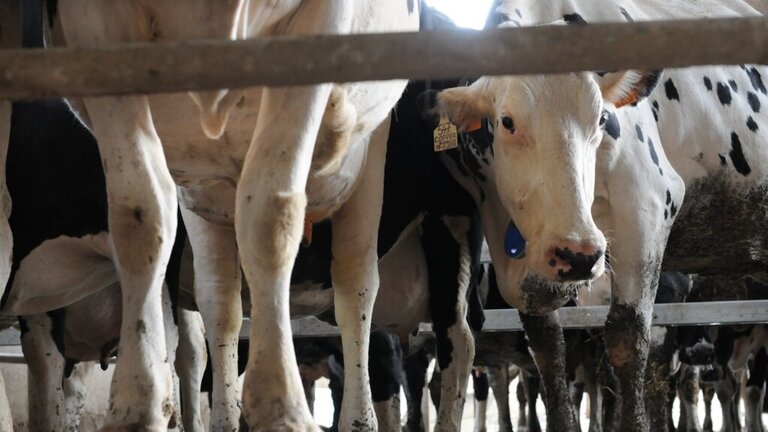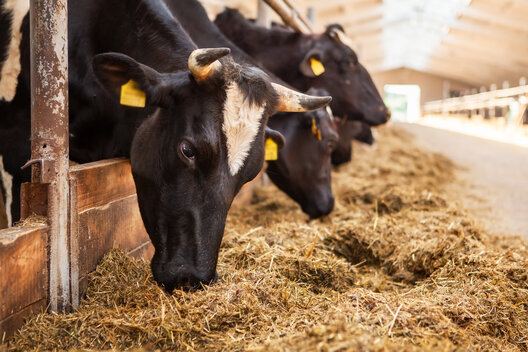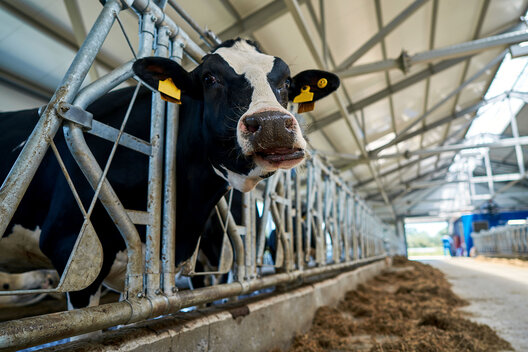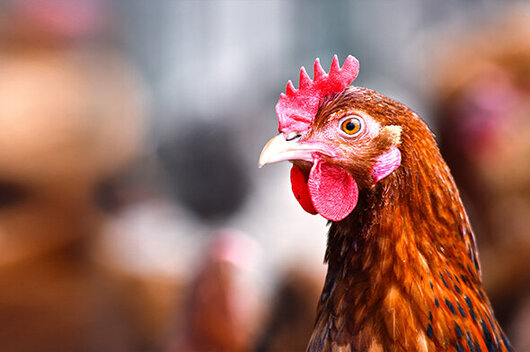Chained up instead of on the pastureHow cattle suffer from tethering
Around 1.1 million cattle live in tethered systems in Germany. 479,000 of them are dairy cows. Chained up in barns, they cannot move freely or get out into the fresh air. For some of the animals, this applies for several months of the year. Others have to endure tethering for their entire lives. In our view, this is systematic cruelty that should have been banned long ago.
What is tethering?
In tethering , cattle are fixed to a place in the barn with chains or fixed neck frames. They then stand there day in, day out. Tethered like this, they cannot take any steps to the right or left, let alone turn around or move freely. They can't even groom themselves or simply lick their backs when they itch. The cows have no opportunity to roll around or be close to their herd.
The animals in tethered husbandry can only eat, lie down and stand up. But even this does not work on all farms. This is because the space available to the cows in the barn is often so small that they cannot all lie down at the same time. They then obstruct or even injure each other. Around 1.1 million cattle vegetate in this way in Germany. Just under half of them are dairy cows. The others are young animals aged six months or older, bulls, heifers - i.e. young cows that have not yet had a calf - and suckler cows.
Difference between seasonal and year-round tethering
Year-round tethering: Many cows live in tethering 365 days a year. This means they have to endure this bleak life all year round - for the rest of their lives.
Seasonal tethering: Cattle in so-called seasonal tethering are tied up for six or nine months at a time. They usually spend the summer on pasture. Seasonal tethering is not a protected term and there are no binding requirements for it. For this reason, dairy farmers, dairies and politicians in Bavaria and Baden-Württemberg have agreed that seasonal tethering should at least meet the criteria of so-called combined husbandry. A euphemistic term in which the word tethering no longer appears. According to the husbandry criteria, cows must then be able to move for 90 to 120 days a year. Combined husbandry is intended to make it easier for farms to move away from year-round tethering.
Seasonal tethering still contrary to animal welfare
Seasonal tethering or so-called combined husbandry does mean an improvement compared to year-round tethering, as the cows can move around for 90 to 120 days a year. With seasonal tethering, this is sometimes the case for even longer. However, even with interim grazing, this is also contrary to animal welfare, as 120 days means 245 tethered days in the barn.
Anyone who keeps animals according to the criteria of so-called combined husbandry does not necessarily let them out on lush green pasture in summer. This is not mandatory. There are also no specifications as to how large the area must be on which cows can move around without a chain, rope or frame. According to the criteria for this form of husbandry, it is sufficient for farmers to allow the cows to move around in the exercise yard for a certain period of the year. Even pens, i.e. separate areas of a few square meters in the barn, are considered sufficient.
Seasonal tethering can also be found on organic farms. Here, in addition to grazing in summer, the animals must be given exercise at least twice a week in an exercise yard in winter.
How cattle suffer in tethered husbandry
Cows cannot move freely, turn around or make friends in their herd for months or their entire lives.
Cows have been bred larger and larger in recent decades, but most tie stalls have not been converted accordingly. As a result, the animals sometimes stand on grates over manure and urine because the areas are too small.

Standing on the grid can cause their joints to swell or their udders to become inflamed. If the lying areas are not sufficiently littered with straw, further injuries can occur - just like in loose-housed barns.
Old barns are often dark & poorly ventilated. Cows stand in high humidity and suffer from the heat in summer. Some cows are tethered in such a way that they stare monotonously at the same wall day and night. No variety for the intelligent and curious animals.
How long is tethering still permitted?
The current German government wants to ban year-round tethering after a transitional period of ten years. It has stated this in its draft amendment to the Animal Welfare Act. Seasonal tethering is to remain permitted. The fact that both forms are (still) permitted contradicts the Animal Welfare Act. This states that "anyone who keeps, cares for or has to care for an animal must accommodate the animal in a manner appropriate to its species and its needs [...] and must not restrict the animal's ability to move in a way that causes it pain or avoidable suffering or harm."

Fact checkingWhy does tethering exist at all?
For a long time, most cattle in Germany were tethered. This has changed since loose-housed barns were established in the 1980s. Nevertheless, many farmers still stick to this practice and keep a total of 1.1 million cattle tethered in Germany. We take a look at their arguments for doing so and explain why they are just as outdated as tethering itself.
In most discussions, proponents of tethering refer solely to dairy cows. They warn of the high costs of building new milking parlors, new buildings or conversions if they have to change the husbandry. However, there are subsidies for them, which is why many farmers have already built them. However, the majority of other cattle that are not dairy cows also have to live tethered. These young or fattening animals are not milked. It would be much easier to keep them in a different, more animal-friendly housing system, and the conversion would be significantly cheaper - and would be subsidized. The trade is also called upon to pay more for better animal husbandry, because farmers need planning security and a milk price that they can live on and pay back their loans.
Proponents of tethering in mountain regions often emphasize that the cows graze on the mountain pastures during the summer months in seasonal tethering. A ban on tethering would therefore also mean the end of these sceneries, which are popular with tourists. However, there is no reason why grazing should not continue in the mountains if the cows at least live in well-built loose housing during the stable months. The proportion of mountain pastures on which cattle are kept is currently declining steadily, even without an end to tethering. This is mainly due to conflicts with excursionists and farmers who are retiring.
An argument that the industry likes to use: cows in loose housing are more likely to have their horns removed than those in tethered housing. However, this does not justify the monotonous and torturous husbandry with chains, straps or neck frames. We are also fundamentally opposed to dehorning. This is because the horns have important functions, as the animals need them for communication and social interaction, use them to scratch themselves and dissipate excess body temperature.
Demands of the German Animal Welfare Federation
- We have been calling for years for a ban on all tethering of cattle - whether year-round or seasonal. And to do so definitively and as quickly as possible. It is not compatible with the national goal of animal welfare to keep animals tethered for long periods of time.
- Politicians and the agricultural sector must continue to promote or encourage the construction of loose housing and outdoor runs. Numerous examples have long shown that it is possible to convert even small tie stalls in such a way that the farms can cope with this economically and at the same time keep their cows in an animal-friendly manner.
- Policymakers must provide financialsupport to farmers who are unable to make such conversions in order to help them exit cattle farming.
Further reading
Position paper of the German Animal Welfare Association on the tethering of cattle (German language)

